|
|
 |
Fiche d'espèce de Copépode |
|
|
Cyclopoida ( Ordre ) |
|
|
|
Oithonidae ( Famille ) |
|
|
|
Oithona ( Genre ) |
|
|
| |
Oithona frigida Giesbrecht, 1902 (F,M) | |
| | | | | | | Syn.: | no Oithona frigida var. pseudofrigida Rosendorn, 1917 a (p.19, figs.F,M); Owre & Foyo, 1967 (p.107, figs.F); Wellershaus, 1970 (p.482, Rem.F);
no O. frigida : Razouls & Durand, 1991 (p.75) | | | | Ref.: | | | Giesbrecht, 1902 (p.29, Descr.F, figs.F); Wolfenden, 1911 (p.363); Rosendorn, 1917 a (p.16, figs.F,M); Brady, 1918 (p.28, figs.F); Kiefer, 1929 g (p.6, Rem.F,M); Farran, 1929 (p.210, 283); Vervoort, 1951 (p.149, Rem.); 1957 (p.145, Rem.); Tanaka, 1960 (p.58, figs.F); Wellershaus, 1970 (p.480, 481, Rem.F); Bradford, 1971 b (p.28, Rem.); Shuvalov, 1980 (p.104, figs.F,M, Rem.M); Björnberg & al., 1981 (p.663, 665, figs.F, Rem.); Nishida, 1985 a (p.45, 48, Redescr.F, figs.F, Rem., p.133); Razouls, 1995 (p.182, figs.F,M); Menshenina & Melnikov, 1995 (p.129); Bradford-Grieve & al., 1999 (p.886, 966, figs.F); Wend-Heckmann, 2013 (p.114, 117, 126, Table 3, 4, 7.8) |  Issued from : S. Nishida in Bull. Ocean Res. Inst., Univ. Tokyo, 1985, No 20. [p.47, Fig.22]. Female (S Indian Ocean): a, thoracic segment 5 and genital segment partial (lateral right side); b, P5; c, anal segment and caudal rami (dorsal); d, idem (ventral); e, Mx2; f, Mxp; g, P1; h, P2; i, P3; j, P4.
|
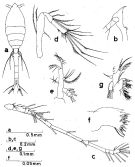 Issued from : S. Nishida in Bull. Ocean Res. Inst., Univ. Tokyo, 1985, No 20. [p.46, Fig.21]. Female: a, habitus (dorsal); b, forehead (lateral); c, A1; d, A2; e, Md (mandibular palp); f, Md (biting edge); g, Mx1. Nota: Proportional lengths of urosome and caudal ramus 10:30:16:15:15:14. Mx1: inner lobe 1 with 3 thick distal marginal setae about equal in length; outer lobe 1 and outer lobe 2 each with 1 seta; inner lobe 3 with 1 thick spinulose seta, 1 longer seta and 1 fine seta; endopodite oval, with 1 seta about twice as long as endopod itself; exopodite with 3 setae.
|
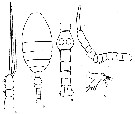 issued from : I. Rosendorn in Wiss. Ergebn. dt. Tiefsee-Exped. \"Valdiviella\", 1917, 23. [p.17, Fig.7]. Female: a, P4. Nota: Proportion of lengths (p.cent) Prosome : 64.1, Urosome : 56.09 . Relative lengths of urosomal segments and caudal rami: 6: 12: 6: 6: 7: 6.5. Setal formula of the exopod swimming legs P1 to P4 (Se = outer setae ; Si = inner setae), P1 : 1, 1, 3 Se ; 1, 1, 4 Si ; P2 : 1, 1, 2 Se ; 0, 1, 5 Si ; P3 : 1, 0, 1 Se ; 0, 1, 5 Si ; P4 : 0, 0, 1 Se ; 0, 1, 5 Si . Distal outer seta of exopod 3 of P4 long (compare with O. pseudofrigida). Male: b, habitus (dorsal); c, urosome; d, left A1; e, Md (mandibular palp). Nota: Proportion of total lengths (p.cent) Prosome : 65.48, Urosome : 34.52 . Relative lengths of urosomal segments and caudal rami: 10 : 16 : 11 : 9 : 7 : 7 : 10.
|
 issued from : I. Rosendorn in Wiss. Ergebn. dt. Tiefsee-Exped. \"Valdiviella\", 1917, 23. [p.18, Fig.8]. Male: a, P1; b, P2; c, P3; d, P4. Setal formula of the exopod swimming legs P1 to P4 (Se = outer setae), P1 : 1, 1, 3 Se ; P2: 1, 1, 3 Se ; P3 : 1, 1, 3 Se ; P4 : 1, 1, 2 Se.
|
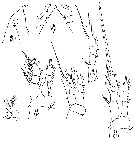 issued from : W. Giesbrecht in Copepoden. Res. voyage du S. Y. Belgica. Rapports scientifiques, Zoologie, 1902. [Taf. VI, Figs.10-16]. Female (from Antarctic): 10, forehead (lateral); 11, idem (dorsal); 12, Mx1: 13, P1; 14, P2; 15, exopod of P3; 16, P4.
|
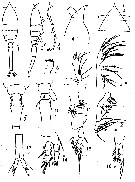 issued from : V.S. Shuvalov in Opred. Faune SSSR, Nauka, Leningrad, 1980, 125. [p.105, Fig.19]. Female: 1-2, habitus (dorsal and lateral, respectively); 3, A1; 4-5, forehead (lateral and dorsal, respectively); 6, Md (masticatory edge); 7, A2; 8, Mx2; 9-10, thoracic segments 4 and 5, genital segment (dorsal and lateral, respectively); 11, Mx1; 12, Mxp; 13, posterior part of urosome (dorsal); 14, P1; 15, P2; 16, P4.
|
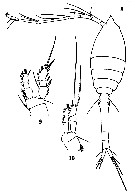 Issued from : O. Tanaka in Spec. Publs. Seto mar. biol. Lab., 10, 1960 [Pl. XXV, 8-10]. Female (from 66°59'S-67°03'E, 41°08'E-40°44'E): 8, habitus (dorsal); 9, P1; 10, P4. figs.9 and 10 at the same scale. Nota: Prosome and urosome in the proportional lengths 54 to 46. Urosomal segments and caudal rami in the proportional lengths 9 : 32 : 15 : 16 : 13 : 15 = 100. A1 13-segmented, extends to the middle of the genital segment. The outer marginal spine on the 3rd exopodal segment of P4 is 1.3 times as long as the segments of the exopod taken together; the coxa is furnished with hairs on the proximal outer margin The carmin-red colour remained around the oral parts and in the cephalothorax.
|
 Issued from : O. Tanaka in Spec. Publs. Seto mar. biol. Lab., 10, 1960 [p.59]. Female: Number of outer marginal spine and inner marginal seta on the exopodal segments of swimming legs P1 to P4.
|
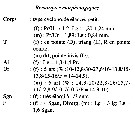 Issued from : C. Razouls in Ann. Inst. océanogr., Paris, 1994, 70 (1). [p.182]. Caractéristiques morphologiques de Oithona frigida femelle et mâle adultes. Terminologie et abbréviations: voir à Calanus propinquus.
| | | | | Ref. compl.: | | | Hardy & Gunther, 1935 (1936) (p.185, Rem., distribution charts); ? Pavlova, 1966 (p.44); Fukuchi & Tanimura, 1981 (p.37); ? Kovalev & Shmeleva, 1982 (p.85); Hopkins, 1985 (p.197, Table 1, gut contents); Kawaguchi & al., 1986 (tab.2); Zmijewska, 1987 (tab.2a); Hopkins & Torres, 1988 (tab.1); Freire & al., 1993 (tab.3); Gonzalez & al., 1994 (p.331); Metz, 1995 (p.190); 1996 (p.34, 87); Atkinson & al., 1996 (p.1387, diel periodicity, feeding); Errhif & al., 1997 (p.422); Atkinson, 1998 (p.289, Table 1, biological data); Elwers & Dahms, 1998 (p.150, 151); Ansorge & al., 1999 (p.135, Table 2, abundance v.s. TS diagram); Razouls & al., 2000 (p.343, tab. 3, 5, Appendix); Chiba & al., 2001 (p.95, tab.4, 7); Hunt & al., 2001 (p.374, tab.1, 2); Dubischar & al., 2002 (p.3871, abundance); Cabal & al., 2002 (p.869, fig.4, Table 1, abundance); Ward & al., 2003 (p.121, tab.4); Hunt, 2004 (p.1, 47, 74, Table 3.2, 4.4, fig.4.7, 4.11); Bielecka & Zmijewska, 2005 (p.96); Hunt & Hosie, 2006 (p.1203, tab.2); Tsujimoto & al., 2006 (p.140, Table1); Deibel & Daly, 2007 (p.271, Table 6b, Rem.: Antarctic polynyas); Fielding & al., 2007 (p.2106, tab.1); Schnack-Schiel & al., 2008 (p.1056, Table 1, 2); Swadling & al., 2010 (p.887, Table 2, 3, A1, abundance, indicator species); Magris & al., 2011 (p.260, abundance, interannual variability); Yang & al., 2011 a (p.921, Table 2, inter-annual variation 1999-2006); Ward & al., 2012 (p.78, Table A1, B1, abundance, weight); Pond, 2012 (p.443, Rem.: p.450, kipid storage); Tarling & al., 2012 (p.222, Table 3, seasonal biomass); Ojima & al., 2013 (p.1293, Table 2, 3, abundance); Ward & al., 2014 (p.305, Table 4, 6, 7, seasonal and abundance in the ''Discovery'' Investigations in the 1930s) | | | | NZ: | 5 | | |
|
Carte de distribution de Oithona frigida par zones géographiques
|
| | | | | | | | |  Issued from : S. Nishida in Bull. Ocean Res. Inst., Univ. Tokyo, 1985, No 20. [p.133, Fig.82]. Issued from : S. Nishida in Bull. Ocean Res. Inst., Univ. Tokyo, 1985, No 20. [p.133, Fig.82].
Indo-Pacific geographical distribution of Oithona frigida. Dotted line: Antarctic Convergence. |
 issued from : I. Rosendorn in Wiss. Ergebn. dt. Tiefsee-Exped. "Valdiviella", 1917, 23. [Taf. I]. issued from : I. Rosendorn in Wiss. Ergebn. dt. Tiefsee-Exped. "Valdiviella", 1917, 23. [Taf. I].
The genus Oithona: Distribution of species sampled during the Deutsche Tiefsee Expedition 1898-99.
The size of symbols indicates the relative quantitty of the species. |
 Issued from : K.M. Swadling, So. Kawaguchi & G.W. Hosie in Deep-Sea Research II, 2010, 57. [p.898, Fig.6 (continued)]. Issued from : K.M. Swadling, So. Kawaguchi & G.W. Hosie in Deep-Sea Research II, 2010, 57. [p.898, Fig.6 (continued)].
Distribution of indicator species Oithona frigida from the BROKE-West survey (southwest Indian Ocean) during January-February 2006.
Sampling with a RMT1 net (mesh aperture: 315 µm), oblque tow from the surface to 200 m.
The survey area was located predominantly within the seasonal ice zone, and in the month prior to the survey there was considerable ice coverage over the western section but none over the east.
See map showing sampling sites in Calanus propinquus. |
 Issued from : A.C. Hardy & E.R. Gunther in Discovery Reports, 1935 (1936), 11. [p.184, Fig.84]. Issued from : A.C. Hardy & E.R. Gunther in Discovery Reports, 1935 (1936), 11. [p.184, Fig.84].
Charts showing the distribution of Oithona frigida) in the upper layers of waters at stations in the 1926-7 surveys around South Georgia.
The squares represent the average numbers per 50 m vertical haul from 250 m (or less at shallow-water stations) to the surface with N 70 V nets. |
 Issued from : D.W. Pond in J. Plankton Res., 2012, 34 (6). [p.450, Fig.7] Issued from : D.W. Pond in J. Plankton Res., 2012, 34 (6). [p.450, Fig.7]
The Southern Ocean copepod, Oithona frigida with multiple oil vesicles throughout the body, although these are often concentrated in the lower prosome. Lipids reserve are, generally, linked to locomotion and/or feeding behaviour.
Nota: The solid-liquid phase transitions of lipids are a factor regulating the buoancy of the copepods. These phase transitions are controlled in relation to the physical environment, through the selective accumulation of specific lipids with optimum levels of unsaturation. The necessity to control buoyancy and maintain an optimum depth is a fundamental evolutionary force, driving anatomical, biochemical and behavioural adaptations within the aquatic realm. It is hypothesized that each species adjusts the amount, composition and anatomical location of lipids, to maximize fitness according to the preferred habitat and life history traits. |
 Issued from : J.A. Cabal & al. inDeep-Sea Res., 2002, 49. [p.876, Fig.4]. Issued from : J.A. Cabal & al. inDeep-Sea Res., 2002, 49. [p.876, Fig.4].
Spatial distribution of Oithona frigida in the Northwest Antarctic Peninsula.
Nota: Geographical distribution of stations groups defined by cluster analysis included in the Antarctic Circumpolar Current area and in the coastal waters of the Peninsula, Bransfield and Gerlache Straits during the ''FRUELA'' cruises (December 1995 - February 1996).
Zoopklankton collected by WP2 net from 200-0 m. |
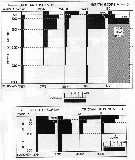 Issued from : A.C. Hardy & E.R. Gunther in Discovery Reports, 1935 (1936), 11. [p.188, Fig.86]. Issued from : A.C. Hardy & E.R. Gunther in Discovery Reports, 1935 (1936), 11. [p.188, Fig.86].
Vertical distribution of Oithona frigida at stations between the Falkland Islands and South Georgia February 1927 and between South Georgia and Tristan da Cunha February 1926.
The scale represents the numbers per 50 m vertical haul taken by a series of closing N 70 V nets.
Horizontal broken lines show the ranges of these vertical hauls. |
| | | | Loc: | | | Antarct. (Croker Passage, Drake Passage, Scotia Sea, King George Is., Potter Cove, Peninsula, Weddell Sea, SW & SE Atlant., Syowa station, Indian, Lützow-Holm Bay, SW & SE Pacif., Ross Sea, Prydz Bay), sub-Antarct. ( N South Georgia, SW Atlant., off Prince Edward Is., Crozet Is., Indian, SW Pacif., Ross Sea), S Indian, off S Tasmania, SW Atlant. (in Björnberg & al., 1981), Brazil (Mucuri estuary), ? [ Aegean Sea (in Pavlova, 1966, p.44), Barbados Is. (in Sander & Moore, 1978, p.233), Yucatan (in Suarez & Gasca, 1989, p.200) ] | | | | N: | 59 | | | | Lg.: | | | (25) F: 1,4-1,13; (31) F: 1,23; (33) F: 1,35-1,25; (35) F: 1,28-1,25; (66) F: 1,35-1,19; (247) F: 1,3; (627) F: 1,24-1,23; (649) F: 1,20; M: 0,84; (880) F: 1,19-1,35; {F: 1,13-1,40; M: 0,84} | | | | Rem.: | épi-bathypélagique.
Sampling depth (Antarct., sub-Antarct.) : 0-1000 m.
Certaines localisations en atlantique subtropicale et en Méditerranée résultent d’une confusion avec O. pseudofrigida.
Voir aussi les remarques en anglais | | | Dernière mise à jour : 17/06/2021 | |
|
|
 Toute utilisation de ce site pour une publication sera mentionnée avec la référence suivante : Toute utilisation de ce site pour une publication sera mentionnée avec la référence suivante :
Razouls C., Desreumaux N., Kouwenberg J. et de Bovée F., 2005-2024. - Biodiversité des Copépodes planctoniques marins (morphologie, répartition géographique et données biologiques). Sorbonne Université, CNRS. Disponible sur http://copepodes.obs-banyuls.fr [Accédé le 25 avril 2024] © copyright 2005-2024 Sorbonne Université, CNRS
|
|
 |
 |

















